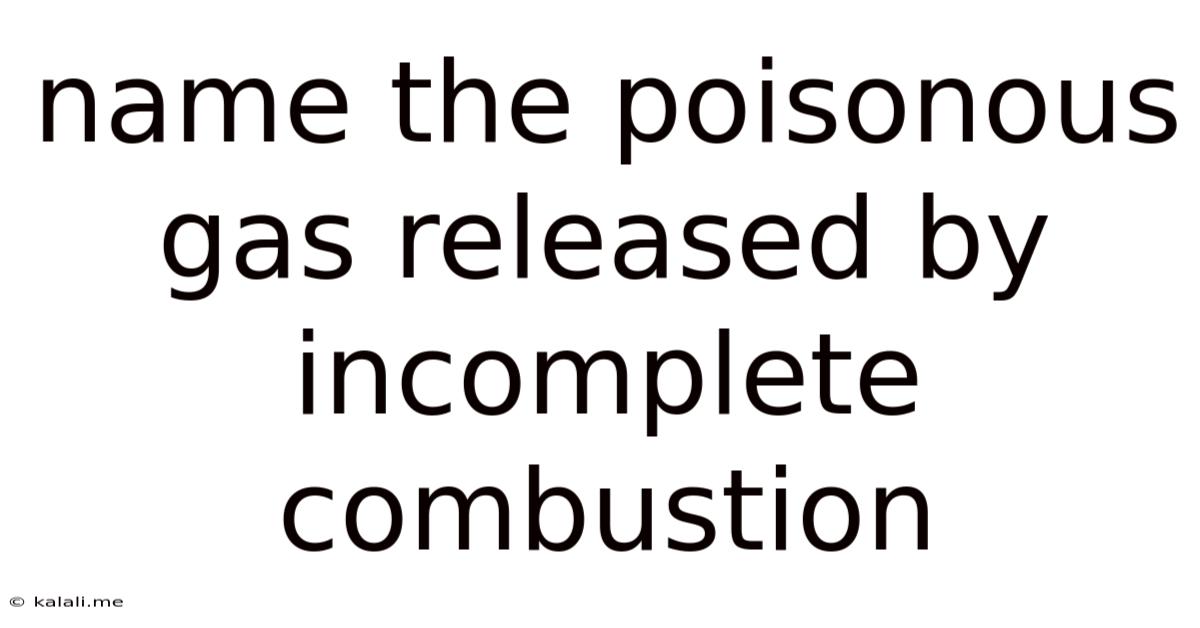Name The Poisonous Gas Released By Incomplete Combustion
Kalali
Jun 11, 2025 · 3 min read

Table of Contents
The Deadly Danger of Incomplete Combustion: Identifying Carbon Monoxide
Incomplete combustion is a dangerous process, often leading to the release of a highly toxic gas: carbon monoxide (CO). Understanding the dangers of CO poisoning and the circumstances that lead to its production is crucial for ensuring safety in homes and workplaces. This article will explore what incomplete combustion is, how it produces carbon monoxide, and the critical steps to take to mitigate the risk.
What is Incomplete Combustion?
Incomplete combustion occurs when a fuel doesn't burn completely due to a lack of sufficient oxygen. Instead of producing carbon dioxide (CO2) and water (H2O), the process yields carbon monoxide (CO), a colorless, odorless, and highly toxic gas, along with other potentially harmful byproducts like soot and particulate matter. This incomplete burning is most likely to occur when there's a limited supply of oxygen to the fuel source.
How Incomplete Combustion Produces Carbon Monoxide
The chemical reaction underlying complete combustion involves the complete oxidation of a fuel source (often hydrocarbons like methane, propane, or butane). With sufficient oxygen, these hydrocarbons react to form CO2 and H2O. However, when oxygen is limited, the process is incomplete, resulting in the formation of CO instead of CO2. The chemical equation illustrates this difference:
- Complete Combustion: CH₄ + 2O₂ → CO₂ + 2H₂O
- Incomplete Combustion: 2CH₄ + 3O₂ → 2CO + 4H₂O
This incomplete oxidation leaves the carbon atom in the fuel only partially oxidized, resulting in the highly poisonous carbon monoxide molecule.
The Dangers of Carbon Monoxide Poisoning
Carbon monoxide is insidious because it's both invisible and odorless. It binds to hemoglobin in the blood much more readily than oxygen, preventing the blood from carrying oxygen to the body's organs and tissues. This can lead to a range of symptoms, from mild headaches and dizziness to severe nausea, loss of consciousness, and even death. Early detection and immediate action are critical in cases of CO poisoning.
Sources of Carbon Monoxide from Incomplete Combustion:
Several common appliances and situations can lead to incomplete combustion and CO production:
- Faulty furnaces and boilers: Cracks or blockages in the exhaust system can restrict airflow, causing incomplete combustion. Regular maintenance and inspections are essential.
- Gas stoves and ovens: Improper ventilation can lead to a buildup of CO. Ensure adequate ventilation when using gas appliances.
- Wood-burning stoves and fireplaces: Incomplete combustion is more likely with poorly maintained or improperly ventilated wood-burning appliances.
- Vehicles running in enclosed spaces: Never run a car or other vehicle inside a garage or other enclosed space without proper ventilation.
- Generators: Similar to vehicles, generators should never be operated indoors or in poorly ventilated areas.
Prevention and Mitigation:
- Regular maintenance of appliances: Schedule annual inspections and servicing of all fuel-burning appliances, including furnaces, boilers, stoves, and fireplaces.
- Proper ventilation: Ensure adequate ventilation in areas where fuel-burning appliances are used.
- CO detectors: Install carbon monoxide detectors on every level of your home, especially near bedrooms. These detectors provide early warning of potentially dangerous levels of CO.
- Know the symptoms of CO poisoning: Be aware of symptoms like headaches, dizziness, nausea, and fatigue. If you suspect CO poisoning, leave the area immediately and seek fresh air. Contact emergency services.
Conclusion:
Carbon monoxide is a silent killer, a byproduct of incomplete combustion that poses a significant threat to human health. By understanding the sources of CO and implementing preventive measures, we can significantly reduce the risk of CO poisoning and protect ourselves and our loved ones. Remember, early detection and prevention are key to avoiding this potentially deadly hazard.
Latest Posts
Latest Posts
-
How Many Times Does 11 Go Into 40
Jul 01, 2025
-
Elvis Presley Gospel One Pair Of Hands
Jul 01, 2025
-
What Is The Fine For Killing A Buzzard
Jul 01, 2025
-
How Old Am I If I Was Born In 1996
Jul 01, 2025
-
What Is 3 X 3 X 3
Jul 01, 2025
Related Post
Thank you for visiting our website which covers about Name The Poisonous Gas Released By Incomplete Combustion . We hope the information provided has been useful to you. Feel free to contact us if you have any questions or need further assistance. See you next time and don't miss to bookmark.